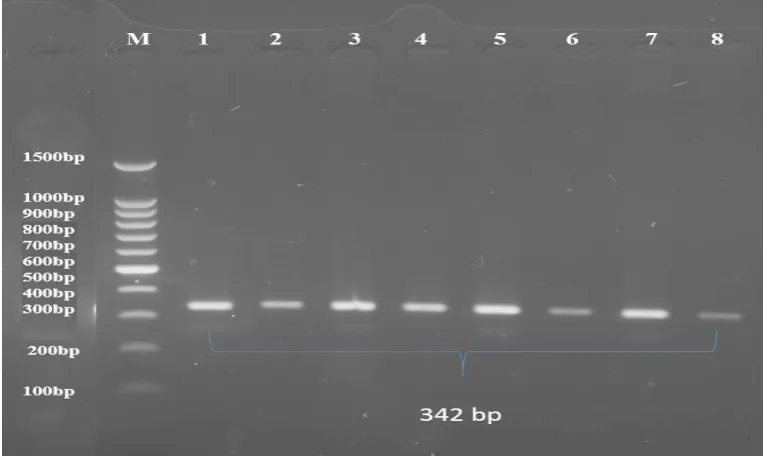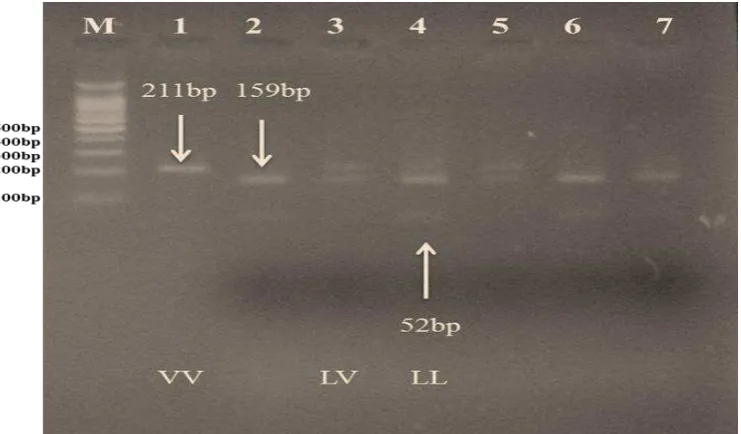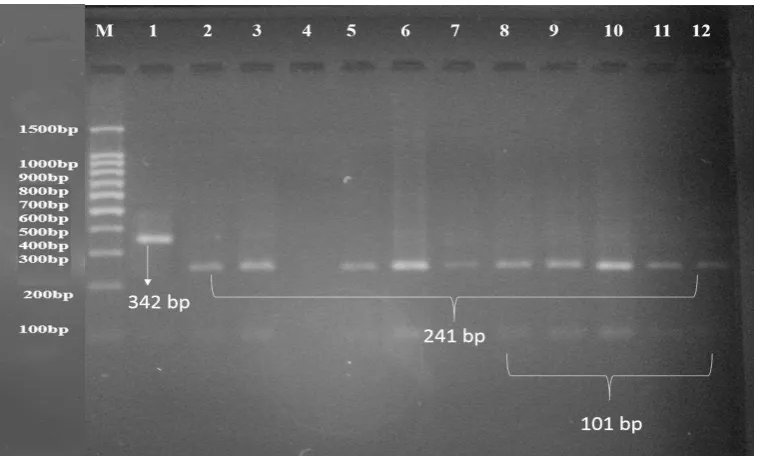IDENTIFICATION OF GH/
ALU
I AND GHR/
ALU
I GENE
POLYMORPHISMS IN IRAQI CATTLE
Dr. Da´ad Ali Hussain* Wisam Hasim Salo* Abd El-Ameer Gareib* Ali Imaad*
*Genetic Engineering and Biotechnology Institute for Postgraduate Studies, Iraq.
ABSTRACT
Associations were analysed between the bovine growth hormone (GH)
as well as growth hormone receptor (GHR) combined with their
genotypes (GH/AluI& GHR/AluI). There is extensive literature on the
genetic polymorphism of GH and GHR in cattle, but perusal of
literature has indicated paucity of information on these two genes in
buffalo. This study aimed to evaluate the genetic polymorphism within
growth hormone and its receptor genes in Iraqi buffalo using
PCR-RFLP technique. Genomic DNA extracted from 100 healthy buffaloes
and amplified using primers that were designed from the cattle GHand
GHR gene sequences. All tested buffalo DNA amplified fragments at
211bp for GH 5th exon. The digestion with AluI endonuclease gave
three types of genotypes. The Distribution of the three genotypes and allele frequency was
calculated according to Hardy-Weinberg equation, were LL=94 (94.09%), LV=6 (5.82%) and
VV=0 (0.09%), so that most of buffaloes was homozygous (LL) and less heterozygous was
for the valine allele as compared with leucine allele homozygous. The amplified fragments of
GHR gene obtained from all tested buffalo DNA at 342-bp were digested with AluI
endonuclease. The result showed that all tested buffaloes are genotyped as GG for GHRgene,
where amplified fragments were digested into two digested fragments at 241and 101-bp due
to the presence of AluI restriction site at position (AG^CT).
KEYWORDS: Buffalo, GH, GHR, PCR-RFLP.
INTRODUCTION
Improvement of important livestock through selective breeding has received more attention
so that annual optimum selective breeding programs may achieve improvement in most of the
economic traits of different farm animals (Pawar et al., 2007). Buffalo (Bubalus bubalis) is
one large ruminant that has its own advantages for development because it can survive with
low quality of feed, tolerant to local parasites and high productivity of meat and milk
(Andreas et al., 2010).
Current advances in molecular genetics are leading to the discovery of individual genes or
candidate genes with substantial effect on traits of economic importance like meat, milk
production and milk quality. Tambasco et al., (2003) have proposed candidate gene strategy.
In other words, the genetic variation of gene is affecting the physiological pathways and
phenotype. The genetic variation of gene would be more likely to affect the phenotype
variation than genes or chromosome regions that are chosen by chance. Several studies
reported that the candidate genes have influenced for preweaning growth traits such as
growth hormone and growth hormone receptor genes (Ge et al., 2003; Kim et al., 2004).
The growth hormone gene is located on 19th chromosome and it is a major regulation gene
for postnatal growth and metabolism in mammals. The growth hormone receptor gene is
located on 20th chromosome and it is a mediation gene of the biological actions of growth
hormone on target cells.
Several studies proved that the genetic polymorphism of growth hormone and growth
hormone receptor genes correlated with preweaning growth traits (Hale et al., 2000; Stasio et
al., 2002). In other words, the genetic polymorphism for both genes was found responsible to
improve economic traits.
The studies on candidate genes in beef cattle from other countries are carried out on growth
(Tambasco et al., 2003; Kim et al., 2004).
The mutation of growth hormone gene on promoter or on the 5th exon depicted one of
changing phenotype since polypeptide chains that are translated from converting DNA. For
example, the mutation on the 5th exon. This substitution illustrated low body weight and
average daily milk production (Lucy et al., 1998). Studies concern with correlation between
growth hormone receptor gene and growth were focused on mutations on promotor region,
few studies reported the effect of exon nine mutations on economic traits (Hale et al., 2000).
The detection of polymorphism makes it possible to identify differences between individual
information from two genes in breeding programs has potential to substantially enhance rates
of genetic improvement.
Consequently, farmers and breeders could utilize the result of this research to genetically
improve preweaning growth traits and use it as basic information for studying about genetic
marker or marker assisted selection in the future.
MATERIALS AND METHODS
Genomic DNA extraction: The total numbers of blood samples were taken from vena jugularis of 100 different sex pubered local buffaloes and were accomplished by reserving
them in EDTA tubes at -20˚C (Miller et al., 1988). Genomic DNA was extracted from whole
blood samples with isolation kit, QIA®mini, (QIAGENE, Germany). Moreover, the DNA
concentration was estimated and the samples were diluted to 30ng/µl in TE at least 24 hours
prior to the reaction.
Polymerase chain reaction (PCR): Amplification of GH and GHR fragments were done by using polymerase chain reaction– restriction fragment length polymorphism (PCR-RFLP)
methods. A 211 bp (GH gene), as well as 342 bp (GHR gene), were amplified by PCR using
forward and reverse primers according to Reis et al., (2001) and Di Stasio et al., (2005)
(Table1).
Reagents used for amplification of both target fragments were performed in a 25 μl reaction
mixtures( Promiga, USA), containing( 2x PCR reaction buffer, 3 mM MgCl2, 400 μM
dNTPs, 10 U Tag DNA polymerase), 5 μl template genomic DNA, while GH primer 1.3 μl
and GHR was 1.25 μl, so far, the sterile water was 12.4, 12.5 μl respectively.
The reaction was cycled for 1 min. at 94°C, 2 min at an optimized annealing temperature that
was determined for each primer (Table 1) and 2 min. at 72°C for 30 cycles.
The PCR products were electrophoresed on 1.5% agarose gel stained with ethidium bromide
at constant voltage (10v/cm) for 30 minutes to test the amplification success (Othman et al.,
Table1. The sequences and information of primers used in this study.
Restriction fragment length polymorphism (RFLP) technique: The PCR products for the two tested fragments were digested with the restriction enzyme AluI. The restriction mixture
for each sample was prepared by adding 2 μl of 10 × restriction buffers to 7 units of the
appropriate restriction enzyme and 0.2 μl BSA; the volume was completed to 20 μl by sterile water. This restriction mixture was mixed with PCR product (~10μl) and incubated at 37˚c
for 3 hours in water bath. The digested PCR products were electrophoresed on 3% agarose
gel at 50 v for 2hours, staining with ethidium promide to detect the different genotypes of the
two tested sequences by UV- transilluminator and finally documented in gel doc
system(Otaviano et al, 2005).
RESULTS AND DISCUSSION
Growth hormone (GH) actions on target cells depend on the GH receptor (GHR) (Burton et
al., 1994). The GH binding to GHRcauses its dimerization, activation of the GHR-associated
JAK2 tyrosine kinase, and tyrosyl phosphorylation of both JAK2 and GHR(Zhu et al., 2001).
These events activate a variety of signaling molecules, including MAP kinases, protein kinase
C, and STAT transcription factors (Maj et al., 2004).
The primers GH, GHR were amplified with DNA fragment, which is used as a template for
PCR reaction. The PCR amplification was confirmed by running 7μl of PCR product along
with 100bp DNA marker in 1.5 agarose gel. The amplified PCR products (GH, GHR) were
visualized as a single band of expected size under the UV with the marker, which were 211bp
Figure (1): PCR products of bovine GH gene with size of 211 bp, amplified with primer GH. The product was electrophoresis on 1.5% agarose gel at5 volt/cm2 for 1hour.Lane M DNA ladder (100-1000), Lane (1-10) PCR products was visualized under U.V light after stain with Ethidium Bromide.
Figure (2): PCR products of bovine GHR gene with size of 342 bp, amplified with primer GHR. The product was electrophoresis on 1.5% agarose gel at5 volt/cm2 for 1hour.Lane M DNA ladder (100-1000), Lane (1-8) PCR products was visualized under U.V light after stain with Ethidium Bromide.
The PCR amplified fragments (211bp) of the primer GH that located on the 5th exon at the
position 2141, which consider the single SNP were lay on the coding region. We can easily
differentiate between 3 different genotypes, VV with undigested one fragment at 211bp, LL
159bp and 52bp. Most of buffalo animals investigated in this study are genotyped as LL. As
were tested buffalo DNA, amplified fragments were digested with AluI endonuclease and
gave two digested fragments at 159bp and 52bp (Figure 3). As a result of the presence of the
restriction site at position 52^53 (AG^CT) for the PCR product, this result supported by
Biswas et al., (2003) and Othman et al., (2012) in their studying on Indian and Egyptian
buffaloes as well as cattle consequently.
Figure (3): The digestion of PCR products (211) of GH gene with AluI enzyme. The product was electrophoresis on 3% agarose gel at 5 volt/cm2 for 1.5 hour, Visualized under U.V light after stain with Ethidium Bromide. Lane M DNA ladder (100-1000), Lane (1): the undigested PCR products of the GH gene with size of 211bp which represented recessive VV genotype, Lanes 2, 4, 6, and 7: the digested form which represented the dominant LL genotype. Lanes 3, 5: digested form which represented the dominant heterogeneous LV genotype.
Distribution of the three genotypes and allele frequency was calculated according to
Hardy-Weinberg equation as shown in table (2), Were LL=94 (94.09%), LV=6 (5.82%) and VV=0
(0.09%), so that most of buffaloes was homozygous (LL) and less heterozygous was for the
valine allele as compared with leucine allele homozygous (Hussain et al., 2014) . However
Kovacs et al. (2006), have obtained same result. On the basis of statistical analyses it can be
found that LL genotyped dams produced milk with significantly higher milk fat and protein
percent. The same association between LL genotype of GH gene with higher milk fat and
protein percent was reported by Reis et al., (2001), Sadeghi et al., (2008) and Jakaria et al.,
(2009). These authors reported an association between LL and LV genotypes with the
of a population using multiple loci can be described by the value of heterozygosity (Nei and
Kumar, 2000).
The mutation of GH 5th exon loci in buffalo were very low. This was indicated by the value
of one genotype percentage. A limited number of males in the population, and the high
inbreeding frequency can cause low diversity in buffalo.
It can be concluded that the diversity of GH gene in Iraqi buffalo was very low and showed
no polymorphisms were detected in these genes. Most buffaloes tested had LL genotype for
locus GH 5th exon loci.
The gene coding for bovine GHRconsists of 9 exons (from 2 to 10) in the translated part and
of a long 5’-noncoding region (Maj et al., 2004). So far, the primers used in this study (Table
1) flanked a 342-bp fragment from exon 9 of Iraqi buffalo GHR gene. The amplified
fragments obtained from all tested buffalo DNA (100 animals) at 342-bp.
Depending on the presence or absence of the restriction site at position 101^102 (AG^CT) in
these amplified fragments, we can easily differentiate between 3 different genotypes. AA
with undigested one fragment at 342-bp, GG with two digested fragments at 241-and 101-bp
and AG with three digested fragments at 342-, 241- and 101-bp.
All buffalo animals investigated in this study are genotyped as GG where all tested buffalo
DNA amplified fragments were digested with AluI endonuclease and gave two digested
fragments at 241- and 101-bp (Figure 4) due to the presence of restriction site at position
Figure (4): The digestion of PCR products (342) of GHR gene with AluI enzyme. The product was electrophoresis on 3% agarose gel at 5 volt/cm2 for 1.5 hour, Visualized under U.V light after stain with Ethidium Bromide. Lane M DNA ladder (100-1000), Lane (1): the undigested PCR products of the GHR gene with size of 342bp, which represented recessive AA genotype, Lanes 2 to 12: the digested form which represented the dominant GG genotype.
These results supported by Andreas et al., (2010) and Othman et al., (2012), while Some
studies showed the substitution at position 256 in cattle (Genbank accession number
AY053546), from A to G. These changes caused a loss of enzyme recognition sites of AluI,
so that produced fragment of the length 298 bp, known as the AG genotype (Ge et al., 2000;
Di Stasio et al., 2005). Genotype found in buffalo in this research was GG genotype
(Figure4).
Genetic diversity based on molecular marker GH AluI and GHR AluI loci in buffalo were
very low.
Dybus and Grzesiak (2006) showed that the GHRH HaeIII and GH MspI genes in buffalo
from Banten Province were Polymorphic. Low diversity in buffalo can be caused by a
100-limited number of males in the population, and the high inbreeding frequency.
In conclusion, it can be concluded that the diversity of GH AluI and GHR AluI genes in Iraqi
buffalo was very low and showed no polymorphisms were detected in these genes. All
REFERENCES
1. Andreas E, Sumantri, Nuraini H, Farajallah A. Anggraeni A. Identification of GH/ ALUI
genes polymorphisms in Indonesian buffalo. J. Indones. Trop. Anim. Agric., 2010; 35:
215-221.
2. Biswas TK, Bhattacharya TK, Narayan AD, Badola S, Kumar P, Sharma A. Growth
hormone gene polymorphism and its effect on birth weight in cattle and buffalo.
Asian-Aust. J. Anim.Sci., 2003; 16: 494-497.
3. Burton JL, McBride BW, Block E, Glimm DR. A review of bovine growth hormone.
Can. J. Anim. Sci. 1994; 74: 167-201.
4. Di Stasio LG, Destefanis A, Brugiapaglia A, Albera A. Polymorphism of the GHR gene
in cattle and relationship with meat production and quality. Anim. Genet. 2005; 36:
138–140.
5. Dybus A, Grzesiak W. GHRH/HaeIII gene polymorphism and its associations with milk
production traits in Polish Black-and-White cattle. Arch. Tierz. Dummerstorf. 2006; 49:
434-438.
6. Ge W, Davis ME, Hines HC, Irvin KM. Rapid communication: single nucleotide
polymorphisms detected in exon 10 of the bovine growth hormone receptor gene. J.
Anim. Sci. 2000; 78:2229–2230.
7. Ge W, Davis ME, Hines HC, Irvin KM, Simmen RCM. Association of single nucleotide
polymorphisms in the growth hormone and growth hormone receptor genes with blood
serum insulin-like growth factor I concentration and growth traits in Angus cattle. J.
Anim. Sci. 2003; 81: 641-648.
8. Hale CS, Herring WO, Shibuya H, Lucy MC, Lubahn DB, Keisler DH, Johnson GS.
Decreased growth in Angus steers with a short TGmicrosatellite allele in the P1 promoter
of the growth hormone receptor gene. J. Anim. Sci. 2000; 78: 2099-2104.
9. Hussain DA, Ghareeb AM, Salo WH. Evaluation of DNA polymorphism in bovine
growth hormone gene by PCR-RFLP method. I.J.S.N. 2014; 5(3): 407-411.
10.Jakaria R, Noor R, Martojo H, Duryadi D, Tappa B. Identification of growth hormone
(Gh) gene MspI and AluI Loci Polymorphism in beef cattle. In the 1st International
Seminar on Animal Industry 2009, Bogor, Indonesia: 2009, pp. 42-46.
11.Kim NK, Seo YW, Kim GH, Joh JH, Kim OH, Chung ER, Lee CS. A previously
unreported DraI polymorphism within the regulatory region of the bovine growth
hormone gene and association with growth traits in Korean Hanwoo cattle. Anim. Gent.
12.Kmiec M, Kowalewska-Luczak I, Kulig H, Terman A, Wierzbicki H, Lepczynski A.
Associations between GHRH/HaeIII restriction polymorphism and milk production traits
in a herd of dairy cattle. J. Anim. Vet. Adv. 2007; 6(11): 1298-1303.
13.Kovacs K, Volgyi- Csik J, Zsolnai A, Gyorkos I, Fesus L. Associations between the AluI
polymorphism of growth hormone gene and production and reproduction traits in a
Hungarian Holstein-Friesian bull dam population. Arch. Tierz. Dummerstorf. 2006; 49:
236-249.
14.Lucy MC, Johnson GS, Shibuya H, Boyd CK, Herring WO. Rapid communication:
polymorphic (GT)n microsatellite in the bovine somatotropin receptor gene promoter. J.
Anim. Sci. 1998; 76: 2209-2210.
15.Maj A, Oprzdek J, Oprzdek A, Dymnicki I, Zwierzchowski L. Polymorphism in the 5’
-noncoding region of the bovine growth hormone receptor gene and its association with
meat production traits in cattle. Anim. Res. 2004; 53: 503-514.
16.Menon RK, Shaufl A, Yu JH, Stephan DA, Friday RP. Identification and characterization
of a novel transcript of the murine growth hormone receptor gene exhibiting development
and tissue-specific expression. Mol. Cell. Endocrinol. 2001; 172: 135-146.
17.Nei M. and Kumar S. 2000. Molecular Evolution and Phylogenetics. Oxford University
Press, New York.
18.Otaviano AR, Tonhati H, Sena JA Muooz A. Kappa-casein gene study with molecular
markersin female buffaloes (Bubalus bubalus). Genet.Mol.Biol. 2005; 28: 237-241.
19.Othman EO, Abdel-Samad MF, Abo El Maaty NA, Sewify KM. Evaluation of DNA
polymorphism in Egyption buffalo growth hormone and its receptor genes. J.
Appl.Biol.Sci. 2012; 6: 37-42.
20.Pawar RS, Tajane KR, Joshi CG, Rank DN, Bramkshtri BP. Growth hormone gene
polymorphism and its association with lactation yield in dairy cattle. Indian J. Anim. Sci.
2007; 77: 884-888.
21.Reis C, Navas D, Pereira M, Cravador A. Growth hormone AluI polymorphism analysis
in eight Portuguese bovine breeds. Arch. Zootec. 2001; 50: 41-48.
22.Sadeghi M, Shahr-e-Babak MM, Rahimi G, Javaremi AN. Association between gene
polymorphism of bovine growth hormone and milk traits in the Iranian Holstein Bulls.
Asian J. Anim. Sci. 2008; 2:1–6.
23.Stasio LD, Sartore S, Albera A. Lack of association of GH1 and POU1F1 gene variants
24.Tambasco DD, Paz CCP, Tambasco-Studart M, Pereira AP, Alencar MM, Freitas AR,
Coutinho LL, Packer IU, Regitano LCA. Candidate genes for growth traits in beef cattle
cross Bos taurus x Bos indicus. J. Anim. Breed. Genet. 2003; 120: 51-56.
25.Zhu T, Goh ELK, Graichen R, Ling L, Lobie PE. Signal transduction via the growth



